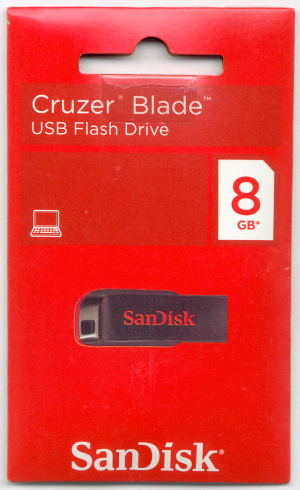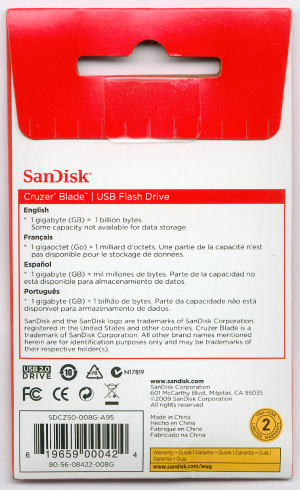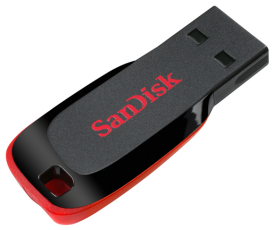

Model: SanDisk Cruzer Blade
Manufacturer: SanDisk
Provided By: Reader Donations
SanDisk has been a leader in the storage industry for more than 20 years. Founded in 1988 by Dr. Eli Harari, the company has grown to become the world's largest supplier of flash memory data storage products. The company offers a wide range of products including memory cards, USB flash drives, SSDs and its popular line of Sansa music and video players.
One of the latest additions to SanDisk's line of USB flash drives is the Cruzer Blade. Available in capacities ranging from 2GB up to 16GB, the Cruzer Blade is about the size of a standard size paper clip and weighs approximately the same as a penny. With its tiny footprint, the drive fits easily on a keychain, giving users the ability to take their favorite music, photos, videos and documents where ever they go. The Cruzer Blade is also compatible with Windows 2000/XP/Vista/7, Mac OS X and Linux and is backed by a five-year warranty.
Packaging:
The Cruzer Blade comes packaged as shown below. Instead of plastic clamshell that would probably end up in a landfill, SanDisk ships the drive in an eco-friendly, cardboard envelope.
Physical Features:
The Cruzer Blade is currently the smallest flash drive in SanDisk's lineup. Measuring 41.5mm long, 17.6mm wide and 7.4mm thick, its about the size of a standard size paper clip and weighs approximately the same as a penny. At this size, the Cruzer Blade is hardly noticeable when placed in a pocket or on a keychain.
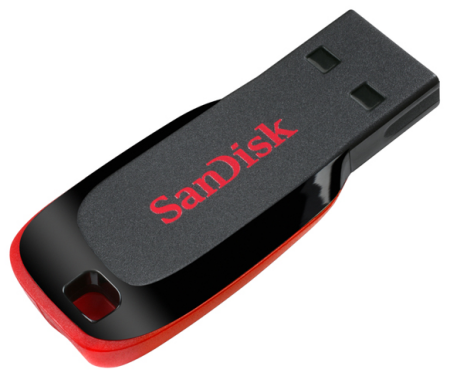
The body and USB connector are constructed out of lightweight, red and black plastic. I was a bit concerned that without a cap, the plastic connector would become damaged. However, it has stood up pretty well to every day use.
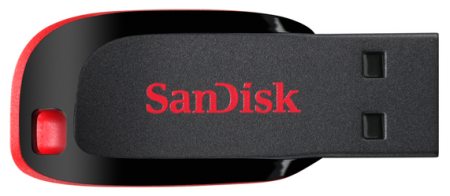
The Cruzer Blade does not have an LED indicator. However, there is a hole on the end so that it can be attached to your key ring.
Installation:
As with most USB flash drives, the Cruzer Blade was very easy to install. Those running Windows 2000, XP, Vista or 7 can simply plug the drive into any available USB port on their computer. If the computer is already turned on, plug and play will automatically detect the drive.
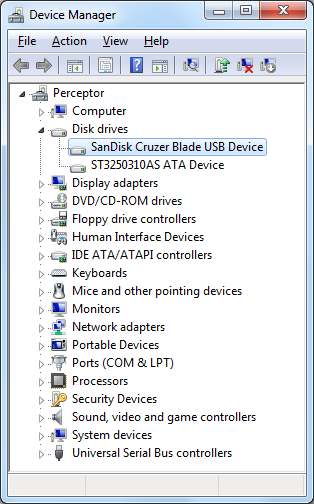
If installed correctly, the Cruzer Blade should show up in the Device Manager. Under Windows 7, the drive is identified as a "SanDisk Cruzer Blade USB Device".
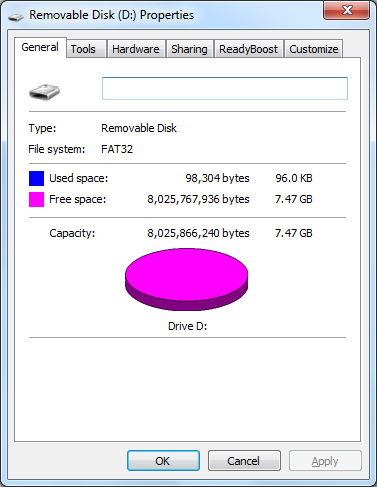
The Cruzer Blade comes formatted with FAT32, giving the 8GB model about 7.47GB of usable space. If you plan to store files larger than 4GB in size, you'll want to convert or reformat the drive with NTFS.
Performance:
The test system used in this review was an HP dc7900. The computer came equipped with an Intel Core 2 Duo E8400 3.0GHz CPU, 2GB of DDR2 800MHz memory, Seagate Barracuda 7200.10 ST3250310AS 250GB SATA hard drive, NVIDIA Quadro FX570 256MB PCIe graphics card and Intel 82567LM-3 gigabit network card. For the operating system, I installed a fresh copy of Windows 7 Enterprise.
To test the performance of the SanDisk Cruzer Blade, I ran a series of benchmarks using CrystalDiskMark 3.0, HD Tach RW 3.0.4.0, ATTO Disk Benchmark 2.46 and SiSoftware Sandra Lite 2010.SP2. To get a feel for the "real world" performance, I also copied and pasted 500MB of random files and directories in Windows Explorer.
CrystalDiskMark 3.0:
First, I ran a few quick tests using CrystalDiskMark. This benchmark tool measures the performance of a storage device by testing its sequential read and write speeds as well as its random read and write speeds using blocks 512K and 4K in size.
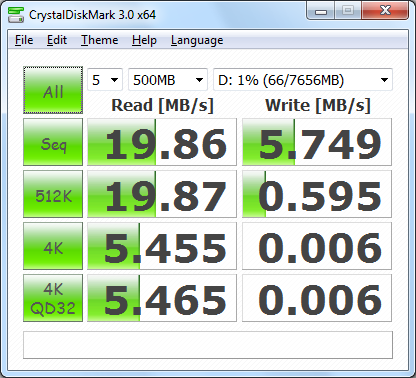
SanDisk doesn't really say what kind of speeds the Cruzer Blade is capable of. Using CrystalDiskMark we can see that the drive is able to read at nearly 20 MB/s and write at 5.7 MB/s.
HD Tach RW 3.0.4.0:
Next, I used HD Tach to test the Cruzer Blade's read, write and burst speeds as well as its seek times and CPU usage.
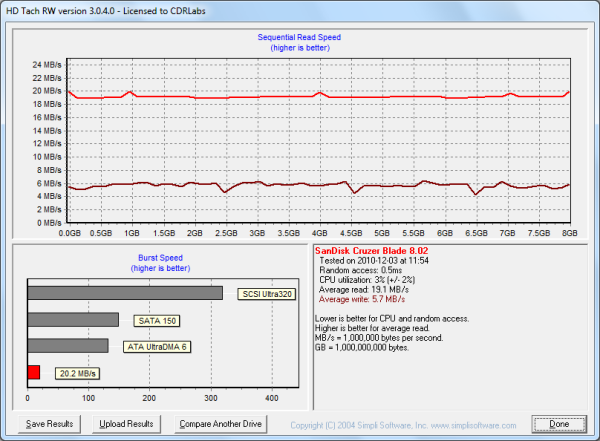
The performance here was very similar to what we saw with CrystalDiskMark. Looking at the screenshot above, you can see that the Cruzer Blade had average read and write speeds of 19.1 MB/s and 5.7 MB/s, respectively, as well as a burst speed of 20.2 MB/s.
ATTO Disk Benchmark 2.46:
I also used ATTO Disk Benchmark to test the Cruzer Blade's sequential read and write speeds. The test was run using blocks ranging in size from 0.5KB to 8192KB and the total length set to 256MB.
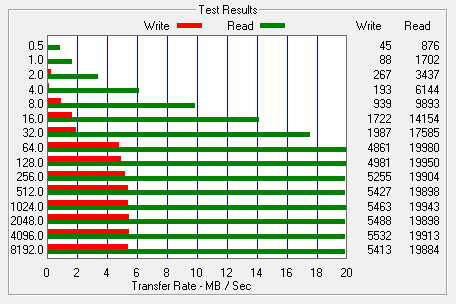
When tested with ATTO, the Ultra Backup topped out at 19.9 MB/s when reading and 5.5 MB/s when writing.
SiSoft Sandra File System Benchmark:
While I am not a big fan of SiSoftware Sandra's optical drive benchmarks, it is a great tool if you want to test a system's performance quickly and easily. One of Sandra's more useful tests is the File System benchmark. This benchmark gives each drive an overall score, or "Drive Index," based on the results of its read and write tests.
| SanDisk Cruzer Blade |
SanDisk Ultra Backup |
Kingston DT Locker+ |
SanDisk Cruzer Enterprise |
|
| Drive Index: | 15.87 MB/s | 17.60 MB/s | 18.55 MB/s | 22.63 MB/s |
| Buffered Read: | 19.53 MB/s | 20.48 MB/s | 21.10 MB/s | 24.62 MB/s |
| Sequential Read: | 19.00 MB/s | 20.00 MB/s | 22.23 MB/s | 24.69 MB/s |
| Random Read: | 19.00 MB/s | 20.00 MB/s | 22.00 MB/s | 24.68 MB/s |
| Buffered Write: | 7.23 MB/s | 895 kB/s | 2.30 MB/s | 5.21 MB/s |
| Sequential Write: | 5.00 MB/s | 11.26 MB/s | 6.00 MB/s | 19.38 MB/s |
| Random Write: | 1.00 MB/s | 2.30 MB/s | 1.70 MB/s | 6.99 MB/s |
SiSoftware Sandra Removable Storage/Flash Devices Benchmark:
Designed with removable storage and flash devices in mind, this benchmark tests a drive's read, write and delete performance using six different file sizes (512 Bytes, 32kB, 256kB, 2MB, 64MB and 256MB). The results are then given in both operations per minute and the corresponding net transfer rate in kB/second. This benchmark also computes an "Endurance Factor," representing the wear and life expectancy of flash devices.
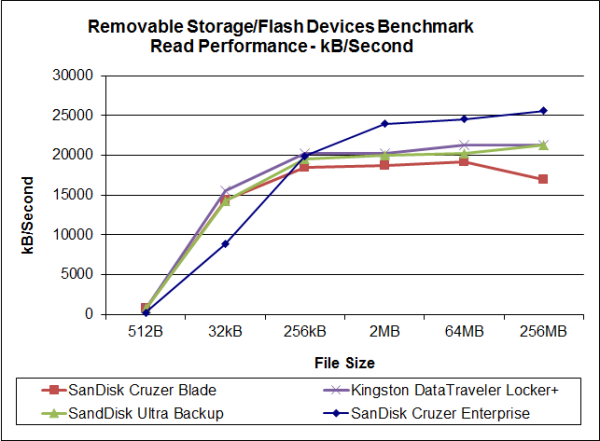
| SanDisk Cruzer Blade |
SanDisk Ultra Backup |
Kingston DT Locker+ |
SanDisk Cruzer Enterprise |
|
| 512B Read: | 811 kB/s | 806 kB/s | 811 kB/s | 248 kB/s |
| 32kB Read: | 14360 kB/s | 14280 kB/s | 15560 kB/s | 8820 kB/s |
| 256kB Read: | 18470 kB/s | 19520 kB/s | 20270 kB/s | 19890 kB/s |
| 2MB Read: | 18670 kB/s | 20000 kB/s | 20270 kB/s | 23930 kB/s |
| 64MB Read: | 19200 kB/s | 20270 kB/s | 21330 kB/s | 24530 kB/s |
| 256MB Read: | 17000 kB/s | 21330 kB/s | 21330 kB/s | 25600 kB/s |
While the Cruzer Blade performed fairly well when reading 512B and 32kB files, it wasn't able to keep up with the other flash drives when reading larger files.

| SanDisk Cruzer Blade |
SanDisk Ultra Backup |
Kingston DT Locker+ |
SanDisk Cruzer Enterprise |
|
| 512B Write: | 33 kB/s | 45 kB/s | 14 kB/s | 42 kB/s |
| 32kB Write: | 325 kB/s | 1250 kB/s | 860 kB/s | 2710 kB/s |
| 256kB Write: | 4000 kB/s | 5570 kB/s | 3000 kB/s | 10270 kB/s |
| 2MB Write: | 2000 kB/s | 3370 kB/s | 2770 kB/s | 13900 kB/s |
| 64MB Write: | 4270 kB/s | 9600 kB/s | 5330 kB/s | 19200 kB/s |
| 256MB Write: | 4270 kB/s | 8530 kB/s | 4270 kB/s | 21330 kB/s |
Here too the Ultra Backup yielded some mixed performance. While the drive was relatively quick when writing small files, it lagged well behind the SanDisk Cruzer Enterprise and Kingston DataTraveler 150 when writing files 2MB and larger.
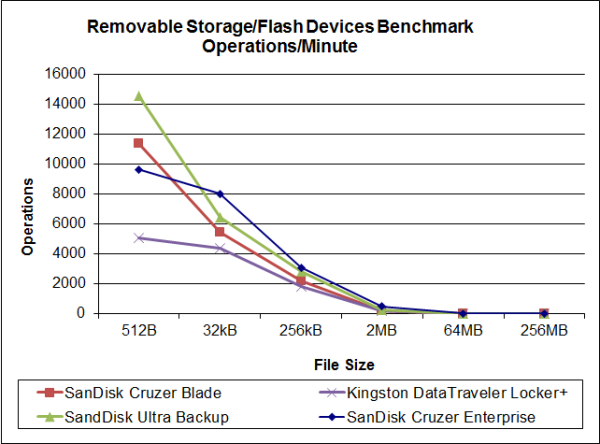
| SanDisk Cruzer Blade |
SanDisk Ultra Backup |
Kingston DT Locker+ |
SanDisk Cruzer Enterprise |
|
| Combined Index: | 4726 | 4828 | 3486 | 5979 |
| 512B Files Test: | 11370 | 14547 | 5083 | 9656 |
| 32kB Files Test: | 5456 | 6451 | 4404 | 8026 |
| 256kB Files Test: | 2196 | 2802 | 1802 | 3095 |
| 2MB Files Test: | 166 | 251 | 216 | 503 |
| 64MB Files Test: | 10 | 15 | 11 | 18 |
| 256MB Files Test: | 3 | 4 | 3 | 5 |
As I mentioned above, Sandra also expresses performance in operations per minute. To keep things simple, I've limited the results to the combined index and the total number of read/write/delete operations for each file size.
| SanDisk Cruzer Blade |
SanDisk Ultra Backup |
Kingston DT Locker+ |
SanDisk Cruzer Enterprise |
|
| Endurance Factor: | 33.00 | 64.30 | 2.20 | 8.60 |
The Endurance Factor represents the wear and life expectancy of a flash device. According to SiSoft, this number is computed by "dividing the average performance (normal condition, i.e. sequential write) to the lowest performance (high-stress condition, i.e. same block re-write)."
"Real World" Benchmark:
To test the "real world" performance of SanDisk's new flash drive, I copied and pasted 500 MB worth of randomly generated files and directories. All of the files are between 10 bytes and 32MB in size and no more than four directories deep.
| SanDisk Cruzer Blade |
SanDisk Ultra Backup |
Kingston DT Locker+ |
SanDisk Cruzer Enterprise |
|
| Write: | 4:03 | 3:22 | 2:50 | 1:02 |
| Read: | 32 seconds | 32 seconds | 31 seconds | 31 seconds |
While the Cruzer Blade had no problems holding its own when reading, it took more than four minutes to write our test data.
Final Thoughts:
With the Cruzer Blade, SanDisk has joined the ranks of companies offering ultra-small USB flash drives. This affordable, paper clip-sized drive easily fits on a keychain, giving users the ability to take up to 16GB of data with them where ever they go. Aside from the Cruzer Blade's exposed USB connector, my only real complaint is its performance. While the drive held its own when reading, its write speeds were quite slow at times.
The Cruzer Blade is available now in 2GB, 4GB, 8GB and 16GB capacities. Suggested retail prices range from $14.99 to $77.99 depending on the size. However, the drive can be picked up for considerably less from Amazon or through some of the vendors on PriceGrabber.
Highs:
- Small and lightweight
- Five year warranty
- Reasonably priced
Lows:
- Slow write speeds
- Exposed USB connector


